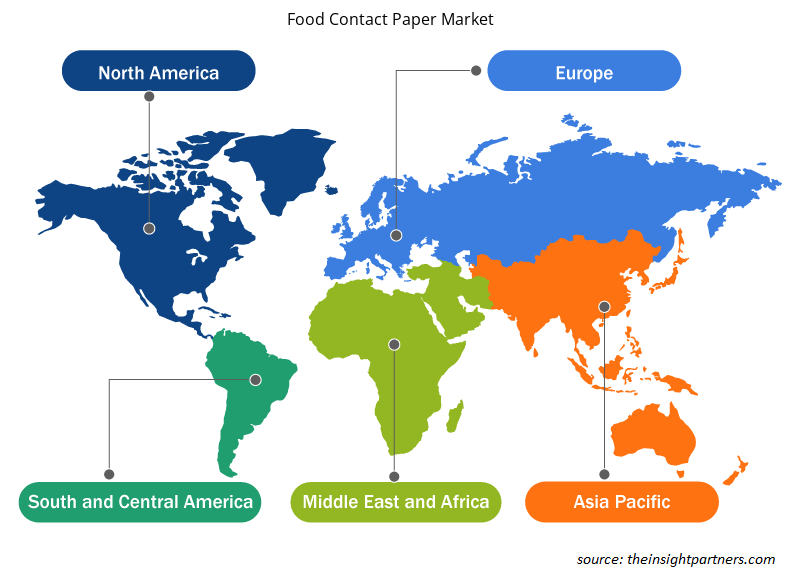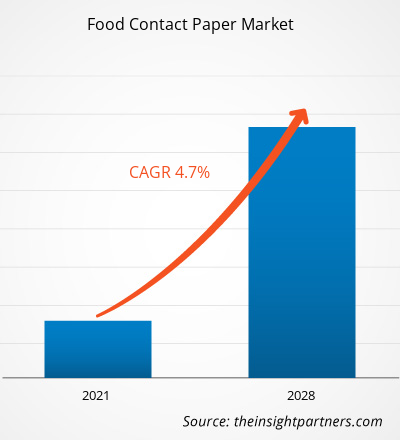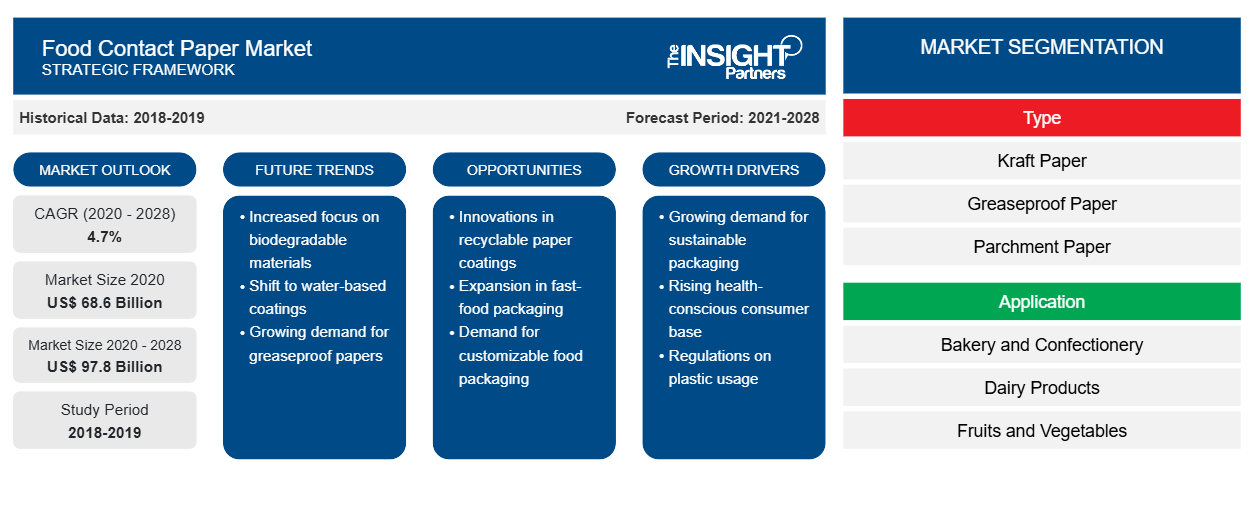Der Markt für Papiere mit Lebensmittelkontakt wurde im Jahr 2020 auf 68,6 Milliarden US-Dollar geschätzt und soll bis 2028 97,8 Milliarden US-Dollar erreichen; von 2021 bis 2028 dürfte er mit einer durchschnittlichen jährlichen Wachstumsrate von 4,7 % wachsen.
Lebensmittelkontaktpapiere werden als Primärverpackungsmaterialien für verschiedene Lebensmittelprodukte wie Backwaren, Süßwaren, Fleisch, Snacks und Getreidemühlenprodukte verwendet. Die Papiere sind nachhaltige Alternativen zu vielen anderen Lebensmittelverpackungsmaterialien wie Kunststoff und Glas. Zunehmende Initiativen von Unternehmen zur Reduzierung ihres CO2-Fußabdrucks beeinflussen die weltweite Einführung von Lebensmittelkontaktpapieren. Die steigende Nachfrage nach nachhaltigen und umweltfreundlichen Lebensmittelverpackungen hat auch die Nachfrage nach Lebensmittelpapierverpackungen erhöht.
Im Jahr 2020 dominierte der asiatisch-pazifische Raum den globalen Markt für Lebensmittelkontaktpapiere und wird seine Dominanz im Prognosezeitraum voraussichtlich beibehalten. Die wachsende Gastronomiebranche in asiatischen Ländern, das steigende Umweltbewusstsein und zunehmende Regierungsinitiativen zum Verbot von Kunststoffverpackungen in mehreren asiatischen Ländern dürften die Nachfrage nach umweltfreundlichen und nachhaltigen Verpackungslösungen beschleunigen, was das Wachstum des Marktes für Lebensmittelkontaktpapiere im asiatisch-pazifischen Raum vorantreiben würde.
Passen Sie diesen Bericht Ihren Anforderungen an
Sie erhalten kostenlos individuelle Anpassungen an jedem Bericht, einschließlich Teilen dieses Berichts oder einer Analyse auf Länderebene, eines Excel-Datenpakets sowie tolle Angebote und Rabatte für Start-ups und Universitäten.
-
Holen Sie sich die wichtigsten Markttrends aus diesem Bericht.Dieses KOSTENLOSE Beispiel umfasst eine Datenanalyse von Markttrends bis hin zu Schätzungen und Prognosen.
Viele Branchen, wie etwa die Chemie- und Werkstoffindustrie, standen aufgrund der COVID-19-Pandemie vor beispiellosen Herausforderungen. Aufgrund des Mangels an Rohstoffen und Arbeitskräften, Fabrikschließungen und anderer betrieblicher Schwierigkeiten im Rahmen der COVID-19-Sicherheitsprotokolle verzeichneten Hersteller von Verpackungsprodukten in den ersten Monaten der Pandemie einen Umsatzrückgang. Darüber hinaus haben die Veränderung des Lebensstils der Verbraucher und ihre veränderten Essgewohnheiten den Konsum von Fertiggerichten und Lebensmitteln, die mitgenommen werden, aufgrund der Ausbreitung des Virus reduziert, was sich negativ auf die Nachfrage nach Lebensmittelkontaktpapieren ausgewirkt hat. Da jedoch mehrere Länder die Ausgangssperre unter angemessenen Vorsichtsmaßnahmen aufheben, dürfte die Nachfrage nach Lebensmittelkontaktpapieren wieder anziehen. Als in mehreren Ländern die Ausgangssperre verhängt wurde, erlebte der E-Commerce-Sektor aufgrund der Schließung von Offline-Geschäften eine erhebliche Nachfrage nach verschiedenen Produkten, wie verpackten Lebensmitteln und Lebensmitteln, darunter frisches Gemüse und Obst, was die Verwendung von Lebensmittelkontaktpapieren ankurbelte.
Markteinblicke
Steigende Nachfrage nach recycelbaren und biologisch abbaubaren Verpackungslösungen
Biologisch abbaubare und wiederverwertbare Verpackungen sind für Verbraucher und Hersteller eine attraktive Alternative zu Einwegverpackungen. Verpackungen für Lebensmittelservices erzeugen in den USA eine erhebliche Menge an Abfall auf Mülldeponien. Laut einem Bericht der US-Umweltschutzbehörde machen Lebensmittelabfälle und -verpackungen den Großteil der in den USA auf Mülldeponien entsorgten Materialien aus. Da Papierverpackungen biologisch abbaubar sind, werden sie wiederverwertbaren Verpackungen vorgezogen. Die Verwendung recycelter Lebensmittelverpackungen erhöht das Kontaminationsrisiko und kann sich dadurch potenziell auf die Umwelt und die menschliche Gesundheit auswirken. Zunehmende Initiativen von Regierungen auf der ganzen Welt zur Verwendung von Einweg-Plastiktüten treiben die Nachfrage nach Verpackungslösungen an, die recycelbar und dennoch nachhaltig sind, was zu einer erhöhten Nachfrage nach Papieren mit Lebensmittelkontakt führt.
Typ-Einblicke
Basierend auf dem Typ ist der Markt für Lebensmittelkontaktpapier unterteilt inKraftpapier, Pergamentpapier, Backpapier und andere. Das Segment Kraftpapier hatte im Jahr 2020 den größten Marktanteil. Das natürliche Kraftpapier besteht aus reinen Frischfasern, was es zu einer idealen Verpackungslösung für Lebensmittelkontakt macht. Das Papier wird zunehmend zur Herstellung verschiedener Papierprodukte mit Lebensmittelkontakt verwendet, wie z. B. Papiertüten, Papiersäcke, Geschenkpapier und Pappteller. Aufgrund seiner hohen Festigkeit wird natürliches Kraftpapier auch zunehmend zur Herstellung von Einkaufstüten für frisches Obst und Gemüse verwendet.
Mondi; Westrock Company; Georgia-Pacific LLC; Twin River Paper Company; UPM; Ahlstrom-Munksjö; GM Packaging (UK) Ltd; Superiorpaper Pty Ltd. TopCare; und KRPA Holding CZ gehören zu den wichtigsten Akteuren auf dem Markt für Papiere mit Lebensmittelkontakt. Wichtige Marktteilnehmer verfolgen Strategien wie Fusionen und Übernahmen sowie Produkteinführungen, um ihre geografische Präsenz und Kundenbasis zu erweitern.
Bericht-Spotlights
- Fortschrittliche Trends in der Lebensmittelkontaktpapierindustrie unterstützen die Akteure bei der Entwicklung wirksamer langfristiger Strategien
- Von Unternehmen verfolgte Geschäftswachstumsstrategien zur Sicherung des Wachstums in entwickelten und sich entwickelnden Märkten
- Quantitative Analyse des globalen Marktes für Lebensmittelkontaktpapier von 2019 bis 2028
- Schätzung der Nachfrage nach Lebensmittelkontaktpapier in verschiedenen Branchen
- Porter-Analyse zur Veranschaulichung der Wirksamkeit von in der Branche tätigen Käufern und Lieferanten bei der Vorhersage des Marktwachstums
- Aktuelle Entwicklungen zum Verständnis der Wettbewerbssituation auf dem Markt und der Nachfrage nach Papieren mit Lebensmittelkontakt
- Markttrends und -aussichten in Verbindung mit Faktoren, die das Wachstum des Marktes für Lebensmittelkontaktpapier vorantreiben und bremsen
- Verständnis der Strategien, die dem kommerziellen Interesse im Hinblick auf das Wachstum des globalen Marktes für Lebensmittelkontaktpapiere zugrunde liegen, und Unterstützung des Entscheidungsprozesses
- Floatglas-Marktgröße an verschiedenen Marktknoten
- Detaillierte Übersicht und Segmentierung des globalen Marktes für Lebensmittelkontaktpapiere sowie seiner Branchendynamik
- Marktgröße von Lebensmittelkontaktpapier in verschiedenen Regionen mit vielversprechenden Wachstumschancen
Regionale Einblicke in den Markt für Lebensmittelkontaktpapier
Die regionalen Trends und Faktoren, die den Markt für Lebensmittelkontaktpapiere während des gesamten Prognosezeitraums beeinflussen, wurden von den Analysten von Insight Partners ausführlich erläutert. In diesem Abschnitt werden auch die Marktsegmente und die Geografie von Lebensmittelkontaktpapieren in Nordamerika, Europa, im asiatisch-pazifischen Raum, im Nahen Osten und Afrika sowie in Süd- und Mittelamerika erörtert.

- Erhalten Sie regionale Daten zum Markt für Lebensmittelkontaktpapier
Umfang des Marktberichts über Lebensmittelkontaktpapiere
| Berichtsattribut | Details |
|---|---|
| Marktgröße im Jahr 2020 | 68,6 Milliarden US-Dollar |
| Marktgröße bis 2028 | 97,8 Milliarden US-Dollar |
| Globale CAGR (2020 - 2028) | 4,7 % |
| Historische Daten | 2018-2019 |
| Prognosezeitraum | 2021-2028 |
| Abgedeckte Segmente |
Nach Typ
|
| Abgedeckte Regionen und Länder |
Nordamerika
|
| Marktführer und wichtige Unternehmensprofile |
|
Marktteilnehmerdichte für Lebensmittelkontaktpapiere: Auswirkungen auf die Geschäftsdynamik verstehen
Der Markt für Lebensmittelkontaktpapier wächst rasant, angetrieben durch die steigende Nachfrage der Endverbraucher aufgrund von Faktoren wie sich entwickelnden Verbraucherpräferenzen, technologischen Fortschritten und einem größeren Bewusstsein für die Vorteile des Produkts. Mit steigender Nachfrage erweitern Unternehmen ihr Angebot, entwickeln Innovationen, um die Bedürfnisse der Verbraucher zu erfüllen, und nutzen neue Trends, was das Marktwachstum weiter ankurbelt.
Die Marktteilnehmerdichte bezieht sich auf die Verteilung der Firmen oder Unternehmen, die in einem bestimmten Markt oder einer bestimmten Branche tätig sind. Sie gibt an, wie viele Wettbewerber (Marktteilnehmer) in einem bestimmten Marktraum im Verhältnis zu seiner Größe oder seinem gesamten Marktwert präsent sind.
Die wichtigsten auf dem Markt für Papier mit Lebensmittelkontakt tätigen Unternehmen sind:
- Mondi
- Westrock-Unternehmen
- Georgia Pacific LLC
- Twin River Papier GmbH
- UPM
Haftungsausschluss : Die oben aufgeführten Unternehmen sind nicht in einer bestimmten Reihenfolge aufgeführt.

- Überblick über die wichtigsten Akteure auf dem Markt für Papier mit Lebensmittelkontakt
Markt für Lebensmittelkontaktpapier nach Typ
- Kraftpapier
- Pergamentpapier
- Pergamentpapier
- Sonstiges
Markt für Lebensmittelkontaktpapiere, nach Anwendung
- Bäckerei und Konditorei
- Milchprodukte
- Obst und Gemüse
- Fleisch, Fisch und Geflügel
- Sonstiges
Firmenprofile
- Mondi
- Westrock-Unternehmen
- Georgia Pacific LLC
- Twin River Papier GmbH
- UPM
- Ahlstrom-Munksjö
- GM Packaging (UK) Ltd
- Superiorpaper Pty Ltd
- TopCare
- KRPA Holding CZ, as
- Historische Analyse (2 Jahre), Basisjahr, Prognose (7 Jahre) mit CAGR
- PEST- und SWOT-Analyse
- Marktgröße Wert/Volumen – Global, Regional, Land
- Branchen- und Wettbewerbslandschaft
- Excel-Datensatz
Aktuelle Berichte
Verwandte Berichte
Erfahrungsberichte
Grund zum Kauf
- Fundierte Entscheidungsfindung
- Marktdynamik verstehen
- Wettbewerbsanalyse
- Kundeneinblicke
- Marktprognosen
- Risikominimierung
- Strategische Planung
- Investitionsbegründung
- Identifizierung neuer Märkte
- Verbesserung von Marketingstrategien
- Steigerung der Betriebseffizienz
- Anpassung an regulatorische Trends























 Kostenlose Probe anfordern für - Markt für Lebensmittelkontaktpapier
Kostenlose Probe anfordern für - Markt für Lebensmittelkontaktpapier